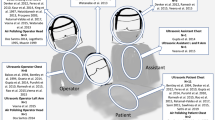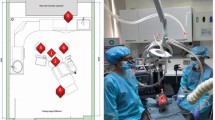Abstract
Cohort selection The aim was to evaluate interventions to minimise microbial contamination from aerosol generating procedures in the dental office. Seven electronic databases were searched using key words such as 'aerosols', 'droplets', 'spatter', 'microbial loads' etc to identify relevant randomised controlled trials and prospective non-randomised clinical trials until 6 April 2020.
Data sources PubMed; Scopus; Cochrane Central Register of Controlled Trials; Cochrane Database of Systematic Reviews; Open Grey; ClinicalTrials.gov; National Research Register; and hand searches.
Data analysis Eligible studies were analysed for effectiveness of various interventions on the microbial counts in the aerosols generated in the dental office using predefined criteria. Data were analysed for assessment of quality of evidence and confidence in the estimated effect, risk of bias and other analyses using Stata 15.1 software. PRISMA guidelines extension for network meta-analysis were followed for reporting.
Results Initial search identified 266 studies, of which 35 were evaluated for full text. Finally, 29 studies fulfilled the eligibility criteria for qualitative synthesis. The majority of the included studies were published in the last decade, and 21 out of the 29 studies were randomised controlled trials. However, based on comparable procedural settings (study design, study populations, interventions and outcome measures), only 11 were eligible for contribution to the network meta-analysis. The setting of all interventions was ultrasonic scaling of adult patients in a clinical dental practice environment, and involved 16 direct and 29 indirect comparisons. A multivariate meta-analysis showed pre-procedural mouth rinse with tempered chlorhexidine 0.2% at 47°C was most effective in reducing post-procedural bacterial load compared to the control. A mean difference of -0.92 (95% CI -15.4 to -0.29) in log10 colony-forming units was observed in air samples within 90 cm of the dental unit.
Conclusions Notwithstanding the limitations of this network meta-analysis, pre-procedural mouth rinse with tempered chlorhexidine appears to be most effective in reducing bacterial counts in aerosols generated during dental operative procedures. Further randomised controlled clinical trials based on robust designs are required to establish the effectiveness of antimicrobial agents in reducing aerosol-related microbial loads (bacteria and viruses) in clinical environments.
Similar content being viewed by others
A Commentary on
Koletsi D, Belibasakis G N, Eliades T.
Interventions to Reduce Aerosolized Microbes in Dental Practice: A Systematic Review with Network Meta-analysis of Randomized Controlled Trials. J Dent Res 2020; DOI: 10.1177/0022034520943574.

GRADE rating
Commentary
Despite the fight against coronavirus disease 2019 (COVID-19) quickly approaching its anniversary, it continues to perplex healthcare professionals and researchers across the globe. Measures to minimise the spread of this pandemic have shown variable success globally and some countries such as the USA, Brazil, Mexico, UK and Italy have been worst affected and have reported high death tolls.1 The risk of a second wave still looms over countries which have managed to flatten the curve of COVID-19 spread.2
COVID-19 pandemic has had the most remarkable impact on the provision of dental care in living memory. Coronavirus (SARS-CoV-2) is known to be present in nasopharyngeal secretions and saliva, and can spread through respiratory droplets and direct contact with inanimate objects.3 Aerosol generating procedures (AGPs) in clinical dentistry remain a particular concern. AGPs can allow the virus to spread for considerable distances which may remain suspended in the air for several hours, rendering the environment a high-risk area for nosocomial spread.4
COVID-19 guidelines for dental professionals emphasise that AGPs should only be undertaken when absolutely necessary and require additional protective measures, such as enhanced personal protective equipment (PPE); use of high-volume suction devices; rubber dam isolation; appropriate fallow time between patients; adequate air ventilation in clinical dental environments; and the use of adjunct pre-procedural antimicrobial mouth rinses.5,6,7,8 However, a recent review of AGPs and their mitigation in international dental guidance documents highlights several challenges: there are considerable variations in the guidance documents vis-à-vis the most appropriate PPE; the role of adjunct antimicrobial mouth rinses; the duration of fallow period following AGPs; and there is lack of consensus on procedures which constitute AGPs in dentistry. More importantly, the review reinforces the need for guidance based on good quality evidence to support the recommendations.9
The current meta-analysis focuses on the evidence underpinning interventions for minimising microbial contamination of aerosols in the dental office environment. While the use of pre-procedural antimicrobial mouth rinses to reduce microbial load in dental AGPs appears to be a promising option, a major limitation of evidence emanating from this review is that the included studies only evaluate the effects of interventions on aerosolised bacterial loads. Given that the most immediate and paramount concern at present relates to the spread of COVID-19 during dental AGPs, the findings appear to fall short of addressing this current challenge.
As highlighted by Koletsi et al. (2020), there is a clear need for further research based on well-designed randomised controlled trials. Such studies may need to incorporate laboratory-based components to investigate the effects of pre-procedural mouth rinses on contamination of aerosols by viruses, and more specifically by SARS-CoV-2. Robust evaluation of virucidal effects of antimicrobial agents presents additional challenges related to viral culture; titration conditions for determining viral concentrations; and cytotoxicity control for antimicrobials to discriminate virus-induced cytopathic changes from cell-toxic effects etc.10
It is known that COVID-19 in the oral cavity may be derived from upper and lower respiratory secretions, while COVID-19 in the blood can access the mouth via crevicular fluid.11,12 Additionally, it may be expressed in saliva following infection of salivary glands.13 Future research may need to unravel a plethora of uncertainties related to contamination of aerosols in the dental clinical environment, some of which include:
Is there a need for simultaneous application of virucidal agents to the oral cavity as well as nasal cavity?
Is pre-procedural topical application of virucidal agents able to reach inaccessible sites such as the gingival crevice in sufficient concentrations and what are the implications if this is not the case?
Is a single pre-procedural use of virucidal agents adequate to minimise microbial contamination or will repeat applications during a dental appointment need to be determined based on the duration of the procedures?
Does microbial contamination of aerosols vary with the nature of different AGPs, such as use of ultrasonic scalers, high-speed handpieces, triple syringe etc?
The current meta-analysis by Koletsi et al. (2020) has shown that pre-procedural mouth rinse with chlorhexidine has superior effects on reducing microbial contamination of aerosols. Apart from the need to determine the virucidal efficacy of chlorhexidine on SARS-CoV-2, consideration needs to be given to the growing incidence of allergy to chlorhexidine in the general population, including the risk of fatal anaphylaxis.14 Antimicrobial agents including ICX (active ingredients: sodium percarbonate and silver nitrate) and povidone-iodine have demonstrable virucidal activity.15,16 Thus, addition of antimicrobial agents to dental unit water lines (DUWLs) offers another possible avenue for minimising microbial contamination of aerosols. Commissioning of future research to mitigate the effects of AGPs in dentistry will also need to account for costs, health and safety concerns, and research ethics. Notwithstanding the challenges of designing research projects, there is a clear case for investing in this area to address the dental healthcare needs of the population and to support the dental profession.
References
World Health Organisation. Coronavirus disease (COVID-2019) Situation Reports. 2020. Available online at https://www.who.int/emergencies/diseases/novel-coronavirus-2019/situation-reports (accessed August 2020).
Xu S, Li Y. Beware of the second wave of COVID-19. Lancet 2020; 395: 1321-1322.
Centers for Disease Control and Prevention. How it spreads. 2020. Available at https://www.cdc.gov/coronavirus/2019-ncov/prevent-getting-sick/how-covid-spreads.html?CDC_AA_refVal=https%3A%2F%2Fwww.cdc.gov%2Fcoronavirus%2F2019-ncov%2Fprepare%2Ftransmission.html (accessed August 2020).
Peng X, Xu X, Li Y, Cheng L, Zhou X, Ren B. Transmission routes of 2019-nCoV and controls in dental practice. Int J Oral Sci 2020; 12: 1-6.
NHS. Dental policies and procedures. Available online at https://www.england.nhs.uk/primary-care/dentistry/dental-commissioning/dental-policies-and-procedures/ (accessed August 2020).
Scottish Dental Clinical Effectiveness Programme. Resources for COVID-19. 2020. Available online at http://www.sdcep.org.uk/ (accessed August 2020).
Centers for Disease Control and Prevention. Dental Settings 2020. Available at https://www.cdc.gov/coronavirus/2019-ncov/hcp/dental-settings.html (accessed August 2020).
Faculty of General Dental Practice (UK). Implications of COVID-19 for the safe management of general dental practice - a practical guide. 2020. Available online at https://www.fgdp.org.uk/implications-covid-19-safe-management-general-dental-practice-practical-guide (accessed August 2020).
Clarkson J, Ramsay C, Richards D, Robertson C, Aceves-Martins M, on behalf of the CoDER Working Group. Aerosol Generating Procedures and their Mitigation in International Dental Guidance Documents - A Rapid Review. 2020. Available at https://oralhealth.cochrane.org/sites/oralhealth.cochrane.org/files/public/uploads/rapid_review_of_agps_in_international_dental_guidance_documents.pdf (accessed August 2020).
Rabenau H F, Schwebke I, Blümel J et al. Guideline for testing chemical disinfectants regarding their virucidal activity within the field of human medicine: as of December 1st, 2014 Prepared by the German Association for the Control of Virus Diseases (DVV) and the Robert Koch Institute (RKI). Bundesgesundheitsblatt Gesundheitsforschung Gesundheitsschutz. 2020; 63: 645-655.
Zhu N, Zhang D, Wang W et al. A novel coronavirus from patients with pneumonia in China, 2019. N Engl J Med 2020; 383: 727-733.
Silva-Boghossian C M, Colombo A P, Tanaka M, Rayo C, Xiao Y, Siqueira W L. Quantitative proteomic analysis of gingival crevicular fluid in different periodontal conditions. PloS One 2013; DOI: 10.1371/journal.pone.0075898.
Sabino-Silva R, Jardim A C, Siqueira W L. Coronavirus COVID-19 impacts to dentistry and potential salivary diagnosis. Clin Oral Investig 2020; 24: 1619-1621.
Pemberton M N, Gibson J. Chlorhexidine and hypersensitivity reactions in dentistry. Br Dent J 2012; 213: 547-550.
Pelletier J, Tessema B, Westover J, Frank S, Brown S, Capriotti J. In Vitro Efficacy of Povidone-Iodine Nasal And Oral Antiseptic Preparations Against Severe Acute Respiratory Syndrome-Coronavirus 2 (SARS-CoV-2). 2020. Preprint. Available online at https://www.medrxiv.org/content/10.1101/2020.05.25.20110239v1 (accessed August 2020).
Parhar H S, Tasche K, Brody R M et al. Topical preparations to reduce SARS-CoV-2 aerosolization in head and neck mucosal surgery. Head Neck 2020; 42: 1268-1272.
Author information
Authors and Affiliations
Rights and permissions
About this article
Cite this article
Ali, K., Raja, M. Evidence-based strategies to reduce contamination from aerosolised microbes in dental practice environment. Evid Based Dent 21, 80–81 (2020). https://doi.org/10.1038/s41432-020-0108-4
Published:
Issue Date:
DOI: https://doi.org/10.1038/s41432-020-0108-4



